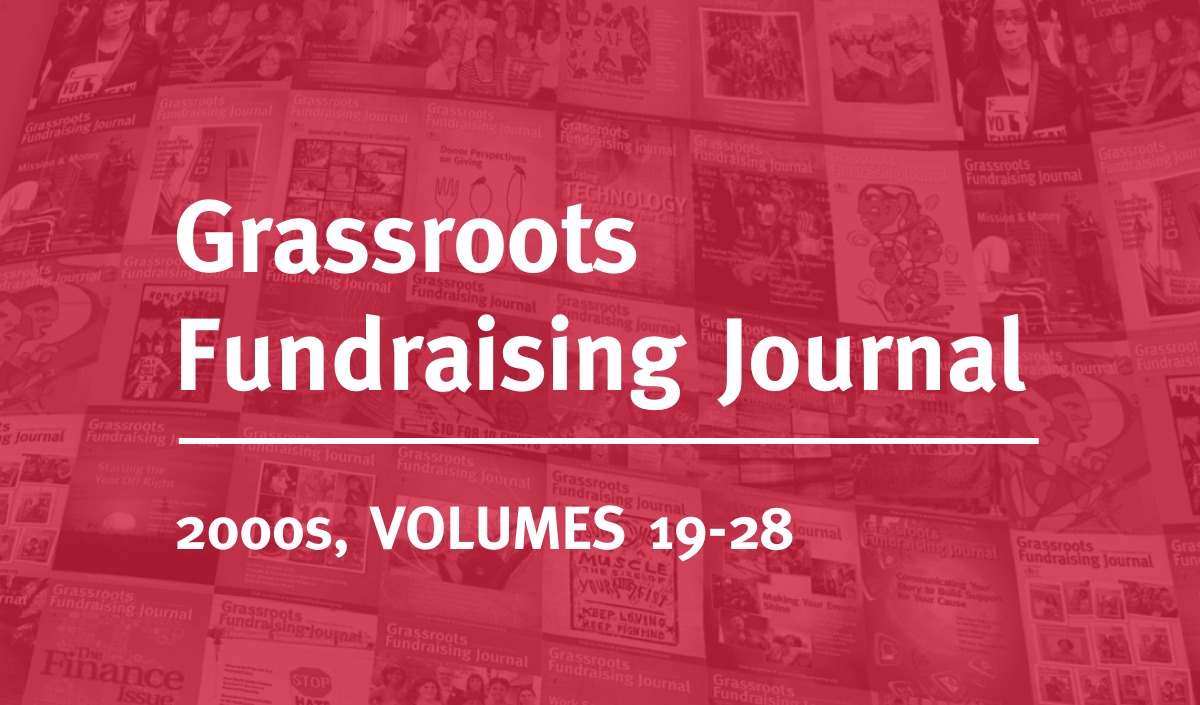This is the opening day of the Council on Foundations conference. We'll be reporting on the big ideas and concepts that might have bearing on what nonprofits around the nation are doing.
American Philanthropic Exceptionalism through the Eyes of Dan Pallotta and Claire Gaudiani–Tempered by Tony Proscio (April 10, 2011, 1:30 p.m.)
Having Clair Gaudiani, Tony Proscio, and Dan Pallotta open the Council on Foundations annual conference gives the program a particular flair. While Proscio is known as a fabulous writer on and for philanthropy, reflecting his long history as a top notch journalist at the Miami Herald, Pallotta and Gaudiani are flashpoints in philanthropy and in the nonprofit world in general. If the Council wanted to stimulate conversation, this is the way to do it.
Are you using all of the tools at your disposal asked the moderator? Proscio took on how foundations speak and write, and what it tells us about how foundations think. Pallotta challenged the nonprofit sector's separation and segregation from the tools of for-profit capitalism. Gaudiani wants foundations to lead in generating a new vision, new hope for our nation.
Proscio was introduced for his attacks on philanthropic jargon. He raised the challenge of the difficult ite is to explain to people about what “we” (meaning philanthropy) do—as distinct from what we believe, what our values might be. He suggested that jargon in philanthropy clouds our thinking. “The more we dwell in…ambiguity, the less clear we are about making things happen,” he said. Attributing this line to former LISC board member Patricia Cloherty, he suggested a better framework: “Who is going to do what to whom for how much?” It's a journalist's perspective. He is asking foundations to think less from a perspective from the academy, where ideas are more valued than action, than the engaged activist, people who focus on the “practical, mundane” answers to effectiveness.
Pallotta “changed the fundamental paradigm for civic causes” through his fundraising bike rides, according to his introducer. His book is the handbook for the nonprofit sector according to SSIR. He asked here, “are we meeting our potential,” is there a blind spot that we aren't getting past. “Is it our job to change these statistics or is it the job of government?” he asked, citing statistics about poverty, AIDS,breast cancer, and hunger that have not improved, but gotten worse over the past few decades. “We blame capitalism for the ills of our sector, but we refuse to let nonprofits use the tools of capitalism to solve problems,” he suggested, citing five areas of discrimination: compensation, advertising and marketing, risk taking in pursuit of new revenues and new donors, time horizon, and profit (nonprofit sector cannot tap profits, thus cannot tap the capital markets).
He argued that the “separate rulebook” for nonprofits puts them at a disadvantage, prevented from generating scale. Eradicate the “economic apartheid,” he advocated. Philanthropy unfortunately focuses on funding “programs” and not fundraising—in funding programs, you buy something, supporting fundraising, you build something, he said. Though the funding he cited as for fundraising was actually unrestricted money, investment in organizations to use to build organizations, not just funding organizations' development departments. He argued for a venture fundraising movement instead of venture philanthropy, to support fundraising, which he defined as “the sacred promotion of civic engagement.” In supporting civic engagement, foundations ought to be supporting nonprofit fundraising.
“The nation right now needs you in the philanthropic sector to give it an aspiration,” Gaudiani said. She moved back to link back to Julius Rosenwald's philanthropy and fast-forwarded to a future of philanthropy having solved health problems such as alzheimer's, breast cancer, and AIDS. It was a speech lauding American exceptionalism as conveyed in our unique ideals. Government has been a tremendous help, but that isn't where innovation occurs, she says, it comes from philanthropy.
Would Proscio shift from a critique of philanthropic jargon to a critique of philanthropic hyperbole? Pallotta and Gaudiani sounded like political campaigners, reaching for broad societal themes attached to the values and initiatives of philanthropy. Pallotta calls for capitalism for nonprofits, Gaudiani sees foundations as the purveyors of America's ability to solve national and international solutions, to convey, promote, and further the solutions that we know—or that Gaudiani says we know—work. This is where philanthropy has its feet in two different worldviews, one that says we're only a half trillion in assets and $41 billion in grantmaking and limited in what it can do and solve on its own, the other than calls on society to look and foundations and envision foundations on their own, without government, without politics, and ostensibly without an ideology other than American exceptionalism, solving complex societal problems.
Whither American Philanthropy in International Development–Acting Globally, Thinking Globally (April 10, 2011, 5:15 p.m.)
Sign up for our free newsletters
Subscribe to NPQ's newsletters to have our top stories delivered directly to your inbox.
By signing up, you agree to our privacy policy and terms of use, and to receive messages from NPQ and our partners.
There is often much that domestic foundations can learn from their counterparts engaged in international development aid. In this instance, Gaudiani's American exceptionalism in the opening might have been tempered somewhat by the admonition of Gerry Salole of the European Foundation Centre in this panel on philanthropy thinking long term about its role in international development, aiming past the Millennium Development Goals timeframe of 2015 toward a longer term perspective aimed at 2020 or beyond.
Salole warned of what most philanthropists sort of innately assume. "The real problem," he said, "is that the solutions are not as simple as people like to think they are…the rhetoric from social engineers is unsatisfying…that things are measured in centimeters of advancement rather than kilometers. How many of the things we listen to are advertisements about fix-it solutions. If they were so easy, we would have done them already." Oh how true! Salole's call for humility rang through the workshop.
Salole's companions on the panel, Todd Moss from the Center for Global Development and Jennifer Barsky from the International Financial Corporation (IFC, part of the World Bank), suggested visions that will, as Moss said, result in the "job of development…that will be completely turned on its head in a few years." Both Moss and particularly Barsky suggested that international development solutions will increasingly be driven by the private sector, solutions in some ways crafted by and relying on the business sector rather than governments and NGOs. Barsky was quite articulate in promoting market-based solutions, citing examples from her work as part of a USAID/Chevron project in Angola some years ago. At the IFC, she says, they look for private sector entities to generate solutions and do the things that governments used to do.
But how will that address Salole's concern that the social engineering premise of much international aid–and some would say, much of philanthropy–is something of a "colonial approach" to development aid, the experts who say, essentially, "I know the answers and they're in my pocket; if I'm technological enough, I can change this." Salole told the assembled foundations that often their best options are to invest in what's on the ground and build on the assets and solutions that people are crafting and implementing at the community level. He also suggested that apprehensions about the misuse or misdirection of development aid could be lessened if more resources were put into community-based organizations because of the community eyes watching the funds.
Both Salole and Moss strongly advocated the idea of foundations working with and through diasporic populations. Salole cited an example of Italian foundations working with African women in Italy to do projects in their home country of Senegal. Both speakers cited the importance of remittances in providing resources to Somalia, for example, when little other assistance is doing much to keep that troubled country afloat.
So what does that leave for philanthropy? Moss suggested that, despite Salole's admonitions for humility, fondations might think like the philanthropic equivalent of hedge funds, the venture capitalists who figure out how things work after whom later stage investors can be brought in. The venture capital experimentation, he suggests, is needed because official donors such as the program officers at USAID, are so risk averse that they will not fund that kind of experimentation. Salole again warned that it is important to work with what is working on the ground and with the people and groups who are inventing new solutions every day, as opposed to imagining that those innovative groups don't exist.
Barsky suggested that foundations with small catalytic grants could get a seat at the table negotiating with international agencies like the World Bank, but the example of the Gates Foundation at the table with the World Bank, as Salole noted, is hardly an example of a small catalytic funder, since it gives out $3 billion a year. Barsky noted, however, that Gates and the other billionaires who are giving away large amounts of charity in their lifetimes "will have a huge influence over the direction of international development."
Moss raised the most intriguing long term challenge. Perhaps, he suggested, the target shouldn't be one of marginally increasing the incomes of the world's poor people, but, if you look at the history of social change and democratization in the developing world, maybe helping to build or foster a middle class. Does a prosperous and thriving middle class promote social progress, democracy, and prosperity? It is an intriguing idea, as he suggested, perhaps making foundation support for business registrations more important, in along term framework, than investments in clean water tablets. Barsky put it in a systems framework, suggesting that foundatoins need to adopt "ecosystems thinking," recognizing the interconnectedness of short, intermediate, and long term issues.
So should foundations be applauding what happened or is still happening in Egypt? Salole cautioned against "counting your chickens before they're hatched," that the story of Egypt hasn't played out, and could turn out not quite what Americans and others want. But Moss noted that the expectations of people have been irrevocably changed.
Undoubtedly true, but if there was a takeaway from this that applies to domestic as well as international foundations, it is a sense of humility and respect, particularly respect for the people on the ground, in communities, that have been developing solutions and building human capital for many years, perhaps off the lenses of foundation social engineers.












